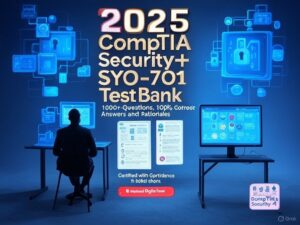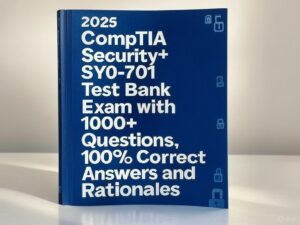Supercharge your cybersecurity certification journey with the “2025 CompTIA Security+ SY0-701 Test Bank Exam with 1000+ Questions, 100% Correct Answers and Rationales,” the most comprehensive and up-to-date preparation tool for the CompTIA Security+ (SY0-701) exam. Tailored for IT professionals aiming to validate their foundational security skills in 2025, this extensive test bank offers over 1,000 meticulously curated multiple-choice questions (MCQs) that span the full breadth of the SY0-701 exam objectives, ensuring you’re ready for every challenge on test day.
Designed to reflect the latest 2024-2025 exam updates, this resource covers all five key domains: General Security Concepts, Threats, Attacks, and Vulnerabilities, Security Architecture, Security Operations, and Security Program Management and Oversight. Each of the 1000+ questions comes with a 100% verified correct answer and an in-depth rationale, providing clear explanations of critical topics like zero-trust architecture, threat intelligence, encryption protocols, incident response, and cloud security. Whether you’re decoding a phishing attack scenario or configuring secure network designs, this test bank bridges theoretical knowledge with practical application, making it an indispensable asset for both novices and seasoned pros.
Crafted by cybersecurity experts with deep insight into CompTIA’s certification standards, this test bank mirrors the exam’s format—up to 90 questions, including performance-based questions (PBQs)—while offering ten times the practice volume for unmatched preparedness. Perfect for self-paced study, group reviews, or intensive exam drills, it’s delivered as an instant digital download, giving you immediate access to a robust question pool that guarantees mastery. With a promise of 100% accuracy in answers and rationales, this 2025 edition is your key to passing the SY0-701 exam with confidence and advancing your career in the ever-evolving field of IT security. Don’t just aim to pass—aim to excel with this ultimate Security+ prep companion!
Preview
Question 1
Which principle ensures that users have only the access necessary to perform their jobs?
A) Defense-in-depth
B) Least privilege
C) Separation of duties
D) Zero trust
Correct Answer: B) Least privilege
Rationale: Least privilege limits access to the minimum required, reducing risk. Defense-in
depth layers security, separation splits tasks, and zero trust assumes no inherent trust.
Question 2
What type of attack uses fraudulent emails to trick users into revealing credentials?
A) Brute force
B) Phishing
C) Spoofing
D) Keylogging
Correct Answer: B) Phishing
Rationale: Phishing uses deceptive emails to steal credentials. Brute force guesses passwords,
spoofing fakes identities, and keylogging captures keystrokes.
Question 3
Which mitigation prevents attackers from exploiting unpatched software?
A) Two-factor authentication
B) Regular patch management
C) Network encryption
D) User awareness training
Correct Answer: B) Regular patch management
Rationale: Patching fixes known vulnerabilities. 2FA adds login security, encryption protects
data, and training addresses behavior, but only patching targets software flaws.
Question 4
What is the primary role of a virtual private network (VPN)?
A) Filter web content
B) Encrypt remote connections
C) Detect intrusions
D) Manage IP addresses
Correct Answer: B) Encrypt remote connections
Rationale: VPNs secure remote access by encrypting traffic. Filtering is for proxies, detection for
IDS, and IP management for DHCP.
Question 5
Which wireless security protocol is considered outdated and insecure?
A) WPA2
B) WEP
C) WPA3
D) TKIP
Correct Answer: B) WEP
Rationale: Wired Equivalent Privacy (WEP) has known vulnerabilities (e.g., weak IVs). WPA2
and WPA3 are stronger, and TKIP is a deprecated WPA component.
Which principle ensures that users have only the access necessary to perform their jobs?
A) Defense-in-depth
B) Least privilege
C) Separation of duties
D) Zero trust
Correct Answer: B) Least privilege
Rationale: Least privilege limits access to the minimum required, reducing risk. Defense-in
depth layers security, separation splits tasks, and zero trust assumes no inherent trust.
Question 2
What type of attack uses fraudulent emails to trick users into revealing credentials?
A) Brute force
B) Phishing
C) Spoofing
D) Keylogging
Correct Answer: B) Phishing
Rationale: Phishing uses deceptive emails to steal credentials. Brute force guesses passwords,
spoofing fakes identities, and keylogging captures keystrokes.
Question 3
Which mitigation prevents attackers from exploiting unpatched software?
A) Two-factor authentication
B) Regular patch management
C) Network encryption
D) User awareness training
Correct Answer: B) Regular patch management
Rationale: Patching fixes known vulnerabilities. 2FA adds login security, encryption protects
data, and training addresses behavior, but only patching targets software flaws.
Question 4
What is the primary role of a virtual private network (VPN)?
A) Filter web content
B) Encrypt remote connections
C) Detect intrusions
D) Manage IP addresses
Correct Answer: B) Encrypt remote connections
Rationale: VPNs secure remote access by encrypting traffic. Filtering is for proxies, detection for
IDS, and IP management for DHCP.
Question 5
Which wireless security protocol is considered outdated and insecure?
A) WPA2
B) WEP
C) WPA3
D) TKIP
Correct Answer: B) WEP
Rationale: Wired Equivalent Privacy (WEP) has known vulnerabilities (e.g., weak IVs). WPA2
and WPA3 are stronger, and TKIP is a deprecated WPA component.











Reviews
There are no reviews yet.